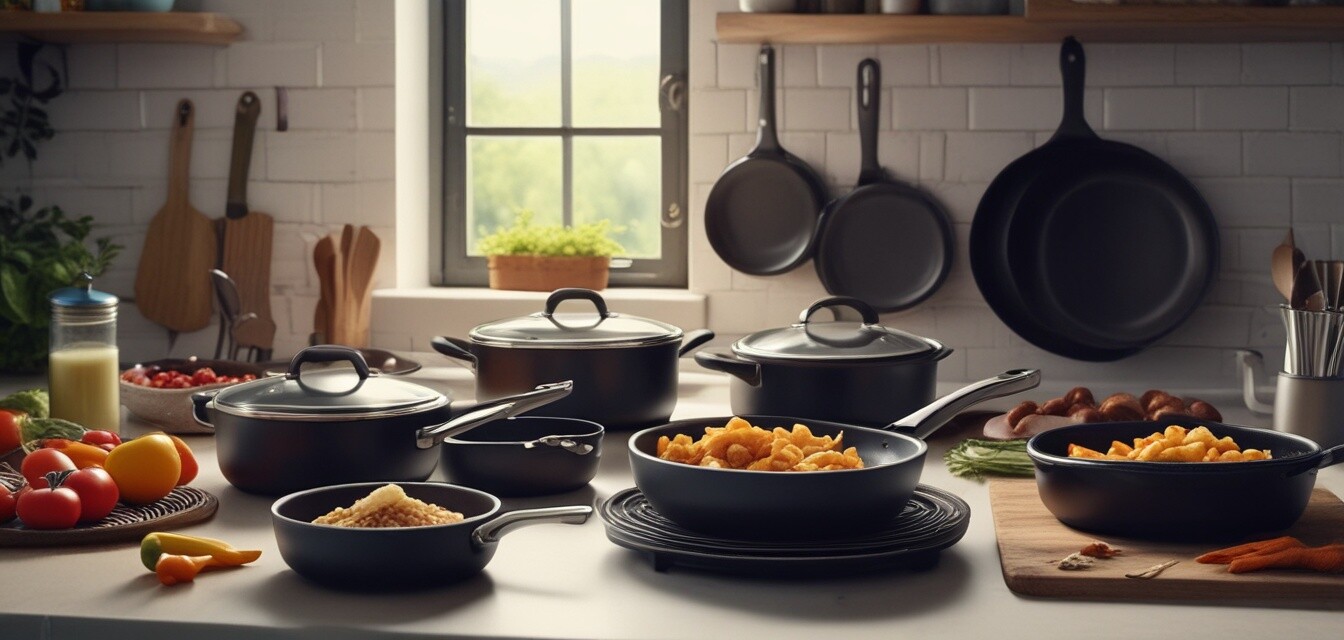
Disclosure: The FTC requires that this article indicate that it was created using AI and is not based on personal experience. It includes affiliate links, which means we may earn a commission if you purchase through these links at no extra cost to you. As Amazon Associates, we earn from qualifying purchases. Product recommendations and endorsements were generated by AI and do not reflect personal opinions or real-world use.
Tips for Cooking with Nonstick Cookware for Groups
Key Takeaways
- Understand the right temperature settings for nonstick cookware.
- Use utensils that will not scratch the nonstick coating.
- Choose appropriate cleaning methods to maintain durability.
- Plan your meals ahead of time for smooth cooking.
- Thoroughly preheat your nonstick pans to enhance cooking efficiency.
Cooking for large groups can be a daunting task, but with nonstick cookware, the process can become much more manageable. Nonstick surfaces offer a great advantage: they allow for easy food release and can reduce the amount of oil needed when cooking. In this article, we'll explore the best practices for using nonstick cookware efficiently when preparing meals for large groups without compromising taste.
Understanding nonstick cookware
Nonstick cookware is coated with a material that prevents food from sticking, which can make cooking and cleaning up much easier. However, understanding how to use it properly will ensure you get the most out of your nonstick pans.
Choosing the right nonstick cookware
When selecting nonstick cookware for group cooking, consider the following:
| Feature | Benefits |
|---|---|
| Durability | High-quality cookware lasts longer and resists scratching. |
| Heat Distribution | Even heat distribution ensures thorough cooking. |
| Size | Larger pans are ideal for cooking for groups. |
| Handle Comfort | Ergonomic handles make lifting heavy pans easier. |
Best practices for cooking with nonstick cookware
1. Preheat your pans properly
Getting your nonstick cookware to the right temperature is crucial. Always preheat your pans on low or medium settings for the best results. This allows for even cooking and helps prevent sticking.
2. Use the right utensils
To maintain the integrity of your nonstick coating, use utensils made from silicone, wood, or plastic. Avoid metal utensils, as they can scratch the surface and ruin its effectiveness.
3. Don’t overheat your cookware
Nonstick pans can be damaged by excessive heat. Aim to use medium heat while cooking to preserve the life of your cookware and ensure an even cooking process.
4. Avoid spraying directly on the surface
Instead of applying cooking spray directly onto your nonstick surface, consider applying it to food or using a light coating of oil. This not only preserves the nonstick coating but also helps ensure evenly cooked food.
5. Proper cleaning techniques
Cleaning is essential to maintaining your cookware. Here are some tips:
- Hand wash with mild soap and a soft sponge.
- Avoid using abrasive cleaning pads.
- Do not put nonstick cookware in the dishwasher.
Meal Planning for Large Groups
Efficient meal planning is key when cooking for groups. Here are some strategies:
- Choose dishes that can be cooked in large batches.
- Use nonstick cookware for versatile dishes, such as stir-fries and frittatas, which can be cooked quickly.
- Plan your menu around seasonal ingredients to enhance flavor and reduce costs.
- Involve helpers in meal prep to speed up the process.
Top meals to cook with nonstick cookware
Some ideal meal options for large groups using nonstick cookware include:
- Stir-fried vegetables with chicken or tofu
- Large frittatas with mixed toppings
- Pasta dishes with creamy sauces
- Pancakes or eggs for breakfast gatherings
- Taco bars with various fillings
Food presentation tips
After preparing your meals, don’t forget to focus on presentation! Here are some tips to make your dishes visually appealing:
- Use white plates to make colorful dishes stand out.
- Garnish with fresh herbs for a pop of color.
- Serve family-style in large bowls for a communal vibe.
Conclusion
Using nonstick cookware efficiently can greatly enhance your cooking experience when preparing meals for groups. By following the tips outlined in this article, you can create delicious meals with minimal hassle. Remember to always care for your cookware properly, plan ahead, and most importantly, enjoy the process of cooking!
Tips for beginners
- Start with basic recipes that require minimal ingredients.
- Practice using your nonstick cookware with simple dishes before moving on to more complex meals.
- Remember, it's okay to make mistakes. Cooking is a learning process!
Pros
- Easy food release and cleaning.
- Healthier cooking with less oil.
- Lightweight and easy to handle.
- Versatile for many types of meals.
Cons
- Can be more delicate than other cookware types.
- Some coatings may wear off over time.
- Potential for health concerns with overheating.
For more information on cookware, be sure to check out our guides on cast iron cookware and large cooking pots to expand your kitchen arsenal!